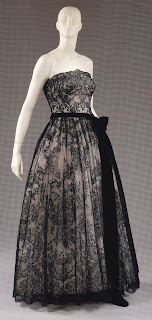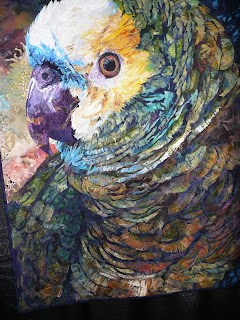Collections: Costume collections the world over are a rich resource for the fashions of the elite. Often, the cult of celebrity has fueled the flames of fashion to reach for the ridiculous as well as the sublime. Certainly this has been true of the fashions of the 18th and 19th centuries. Luckily for those of us interested in the dress, manner and customs of the past, a wealth of "material" survives. While many of the clothes that make up the great collections of the museums of the world have documented fashionable dress for most of the past 300 years, the identity of their owners has been lost. But, having said that, certainly the influences of a handful of women can be seen. My tribute is to the ultimate "Material Girls". Those women who influenced the generation that shared the stage with them.
 |
18th century display, Museum of Costume, Bath
|
At the court of Louis XV of France, Madame de Pompadour was certainly the "it" girl. She met Louis at a masked ball for 5000 at Versailles. The ball was part of the celebrations for the marriage of his son, the Dauphin. Her uncle worked in the cabinet and secured an invitation for her. She came dressed as Diana, Goddess of the Hunt. Louis, along with 15 men of the bedchamber, came dressed as a forest of yew trees. One observer recounted how she ran in and out of the forest of men looking for the king. She certainly was on the hunt. She had such an enormous impact on the manners, customs and design of her day that a colour was created to honor her. "Pompadour Pink". A well educated women, she is shown below in a portrait of grace and refinement. Set in her boudoir, the artist has chosen to contrast her beauty and fashionable appearance against a desk laden with architectural prints, sheet music and published volumes. He wanted us to see that not only was she well educated, but that she was a great patron of the arts and writers of her day. She even supported Diderot with the publication of his Encyclopedia.
 |
| Rose Bertin |
 |
| Marie Antoinette |
Unfortunately, nothing of the fabulous wardrobe of Marie Antoinette survives. At least, not that can be accounted for by hard evidence such as bills, journals or any paintings. The French Revolution swept away any attributions. Although, the shoe that she wore to the guillotine has survived. The dress below, has been attributed to the workshop of Rose Bertin. It is fascinating to ponder the possibility that this garment once donned the body of the ill fated queen.
 |
| Collection of Royal Ontario Museum |
 |
| Collection of Kyoto Costume Institute |
Certainly, the Toronto example, is less exaggerated than the court example on display in Japan. Like the silk worn earlier by Madam de Pompadour, it has been hand painted.
 |
| Empress Eugenie of France |
When the dust of the French Revolution had settled and Napoleon had had his day, the time was ripe for another fashionista. The empress of the second empire, Eugenie. The ultimate clothes horse, it is said that she changed her clothing on average 7 times a day! It is also claimed that she never wore the same gown twice and that when women were invited for the week to the hunting lodge at Compeigne, they packed 28 changes of clothing. A great beauty in her day, she shocked society by wearing eye liner and rouge. Talk about an age of conspicuous consumption. Is it surprising that under her patronage the couture industry in France began?
 |
| Crinoline supported gown, circa 1865 |
At the same time, England had its' own fashion icon. Alexandra, Princess of Wales. Like the late Princess Diana, she too set the trends for a generation. The princess seam was designed to take advantage of her 18" waist. The dog collar necklaces and her favorite color, lilac, to note two more.
 |
| Princess Alexandra of Wales, 1883 |
 |
Museum of Costume, Bath 1896
Gown of Princess Alexandra |
Do the material girls end here? Not on your life. We will revisit this fascinating costume heritage again.
















































